Figures & data
FIG. 1. SAME flight hardware schematic, shown with additional ground testing apparatus within the dotted line. During ground tests, some smoke is diverted from the SAME setup to fill one of the two drums, which hold the diluted smoke for SMPS measurements. Two drums were needed to contain and measure both unaged and aged smoke.

FIG. 2. TEM images showing morphology of smoke particles from ISS testing, all with a reference length scale = 5 μm, with the exception of image (f). (a) Unaged Kapton 574°C, (b) aged Kapton 574°C, (c) Unaged lamp wick, 265°C, (d) Unaged Pyrell, 242°C, (e) Unaged Teflon, 514°C, and (f) ISS residual unaged silicone smoke particles, 380°C, and reference length scale = 2 μm.
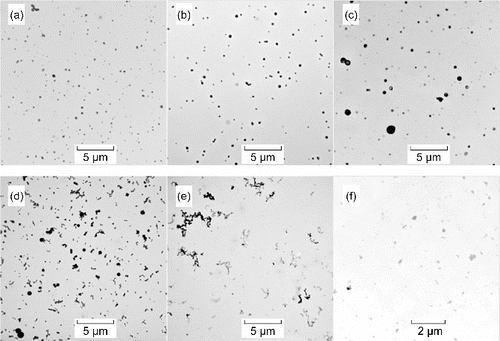
FIG. 3. Ground testing size distributions and residual plots for Kapton (a, b), lamp wick (c, d), and silicone (e, f). Upper images are SMPS measurements, open markers for unaged smoke, and solid for aged; solid curves represent the nonlinear least square fits. Size distribution parameters: (a) Kapton® baseline temperature test (510°C), unaged dg = 139 nm, σg = 1.78, aged dg = 209 nm, σg = 1.66. (c) Lamp wick high-temperature test (286°C), unaged dg = 171 nm, σg = 1.98, aged dg = 248 nm, σg = 1.75. (e) Silicone baseline temperature test (342°C), unaged dg = 257 nm, σg = 1.84, aged dg = 382 nm, σg = 1.56. Residual plots of deviations from lognormal fits are aligned below each size distribution.
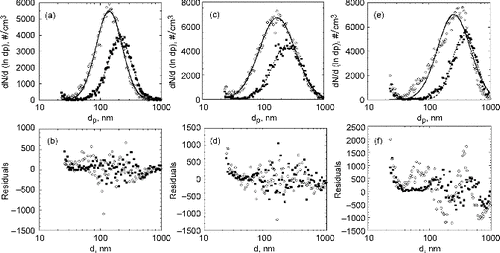
FIG. 4. TEM particle size distributions for Kapton and lamp wick based on projected area equivalent diameters. (a) The effect of aging is shown for a high-temperature Kapton ISS experiment (574°C), circles are unaged smoke, and squares are aged smoke. (b) Ground test number and volume distribution for lamp wick aged test (286°C) from SMPS (circle symbols) and TEM (square symbols). The open symbols are number distribution, and closed ones are volume distribution. Best fit parameters for SMPS are dgn = 248 nm, dgv = 548 nm, σgn = 1.75 and σgv = 1.59, and for TEM are dgn = 123 nm, dgv = 812 nm, σgn = 2.70, and σgv = 1.65.
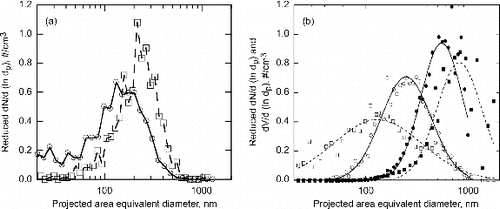
FIG. 5. The percentage of the number, surface area, and volume particle size distributions captured by the SMPS (ground testing) for (a) low-temperature (511°C) unaged Kapton smoke, and (b) high-temperature (370°C) unaged silicone smoke. Black bars represent an SMPS upper limit of 1000 nm (as measured) and white bars represent a more conservative upper limit of 700 nm.
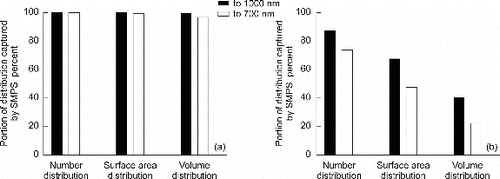
FIG. 6. Two examples of the comparison of diameters calculated from SMPS data (ground testing) in two ways: (1) calculated using discrete SMPS bin data (black bars), and (2) converted by the Hatch–Choate conversion equations using SMPS dg and σg (white bars) for (a) low-temperature, unaged Kapton smoke, and (b) low-temperature, unaged silicone smoke.
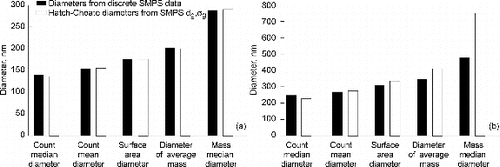
FIG. 7. Comparison of moment method diameters by different techniques. (a) Ground testing diameters calculated from SMPS data in two ways: converted by the Hatch–Choate conversion equations using SMPS lognormal fit dg and σg plotted against diameters calculated using discrete SMPS bin data. All diameters analyzed as in Figure 6 are combined here for all materials and test conditions: open markers are unaged, solid are aged; gray represents baseline temperature, black represents high temperature tests, and marker shapes are Kapton: circle, lamp wick: square, and silicone: triangle. (b) ISS flight data comparison of diameter of average mass by TEM analysis and the moment method.

